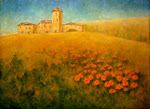How much time should you budget for an excursion in Rome? The Italian writer Silvio Negro said, “A lifetime is not enough.” If it’s to be a painting excursion, I say, “Two life times are not enough.” After you’ve toured the obligatory heavy hitters, i.e.: Trajan’s Forum, Caracalla’s Baths, the Colosseum, Hadrian’s Pantheon, Castel Sant’Angelo, Via Appia, Trevi Fountain, Piazza di Spagna, and the Vatican, it’s time to get down to the business of painting. Back in March, I wrote about my penchant for painting the back streets of Rome. Here are a few of my picks if you prefer not to stray off the beaten path, but still seek a variety of subjects that differ from the norm.
The Villa Borghese is the largest and most beautiful public park in Rome. Impeccably maintained, the park covers approximately a four-mile perimeter, which is more than enough trees, flowers, shrubs, ponds, fountains, and statuaries to keep even the most persnickety plein air artists satisfied. Be sure to bring some water and munchies: Panini, cheese, and fruit can be purchased near all park entrances. Depending on the weather and the time of year, drinks, ice cream, and snacks are sold within the park, but don’t count on it, go prepared.
If you’re not an early riser, be one for at least one day to capture Rome’s silhouette at dawn from across the Tevere (Tiber) at the Gianicolo (Janiculum Hill). With a sky fringed with mauve, the vivid and unforgettable images of bell towers and cupolas are well worth delaying that cup of morning “Joe.”
Rome purists unanimously concur that the Trastevere District is the most authentic Roman district in the city. Some call it a “city within a city.” I call it the most picturesque area of the city and ripe for painting. The architecture is as replete with humorous touches as the dialect of the inhabitants. An artist’s biggest dilemma is deciding where to set up within its charming narrow and irregular streets and its pictorial squares. When in doubt, begin at Piazza Santa Maria in Trastevere. Chances are, as soon as you get your easel set and your palette dotted with paints, a helpful Roman will attempt to lure you to a “special spot.” No, he’s not trying to snare you into a back ally with designs on your wallet and watch; he’s simply making an effort to show an artist (Romans, like all Italians, hold artists in the highest esteem) the best location to get the best angle with the best light. Trust him, follow him, and paint Rome as it was intended.
Try to plan your excursion into the Trastevere District on a Sunday. That way you can include time at the Porta Portese open-air flea market that is held each Sunday from 8am until 2pm. This sprawling market offers great bargains: In addition to the usual clothing and household stalls, you might find anything from termite-eaten Il Duce wooden medallions to pseudo-Etruscan hairpins. And there are bountiful flower stalls with enough flowers to honor each fallen Roman soldier since 300 BC, and fruit and vegetable stalls that are stacked with the most colorful produce imaginable. If you’re a portraiture or caricature artist, the assortment of human subjects, both buyers and sellers, is inexhaustible.
If you prefer to paint a more traditional market scene that is encircled within a piazza, you’ll find none finer than the flower and vegetable market at Piazza Campo di Fiori. Get there early, as the vendors usually close their carts around noon and you shouldn’t miss this explosion of colors. If you enjoy bartering, a quick colored pencil sketch can always be traded for a loaf of bread still warm from the ovens and a kilo of grapes cut ripe off the vine.
BUON VIAGGIO!!!
Welcome
Many artists dream about painting in Italy. Now, as retiring baby-boomers are increasingly taking up “brush and pallet knife,” more than ever, painting in Italy is the “thing.” Every day, a new “Artist’s” tour of Italy crops up in travel sections of the newspaper and on the Internet. But there still remains a majority of artists who prefer to “go it alone.” They are independent in their artistic styles, and prefer to be independent regarding their travels in Italy . This blog intends to target these free spirited artists who still need guidance to the best places to paint, especially those idyllic gems that are little known and less traveled. Certainly, independent travelers who are not artists will also benefit from this blog.
With a few exceptions, this blog is not a guide to restaurants, lodging, rental cars, or shopping, (except for art supplies.)
Sprinkled among the posts are: my paintings, and a few Italian proverbs and poems written by notable Italian authors for whom I work as a translator.
Please visit my website to view my original art:
http://www.pamelaallegretto-franz.com/
Giclee prints of my paintings, ranging from greeting size to poster size, can be purchased at:
http://pamela-allegretto.fineartamerica.com/
With a few exceptions, this blog is not a guide to restaurants, lodging, rental cars, or shopping, (except for art supplies.)
Sprinkled among the posts are: my paintings, and a few Italian proverbs and poems written by notable Italian authors for whom I work as a translator.
Please visit my website to view my original art:
http://www.pamelaallegretto-franz.com/
Giclee prints of my paintings, ranging from greeting size to poster size, can be purchased at:
http://pamela-allegretto.fineartamerica.com/
Thursday, January 7, 2010
Subscribe to:
Post Comments (Atom)











No comments:
Post a Comment
Thank you for your comment. Grazie per i complimenti.
Note: Only a member of this blog may post a comment.